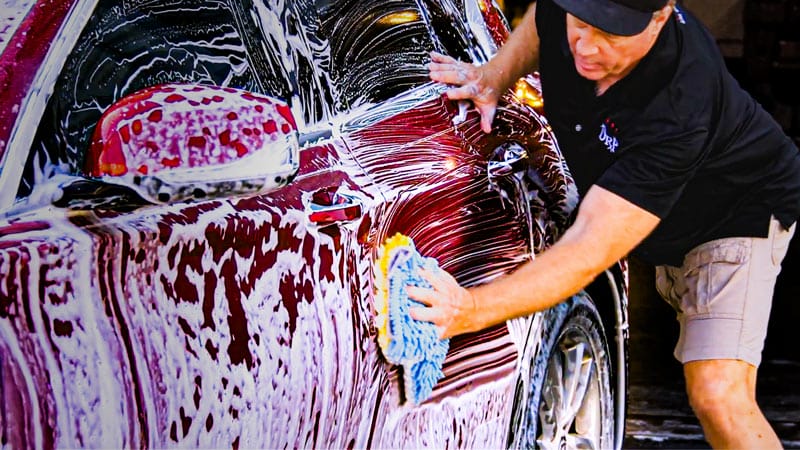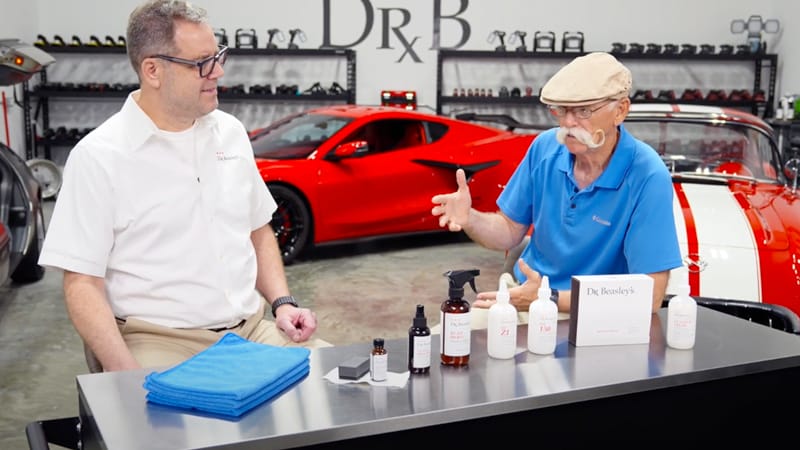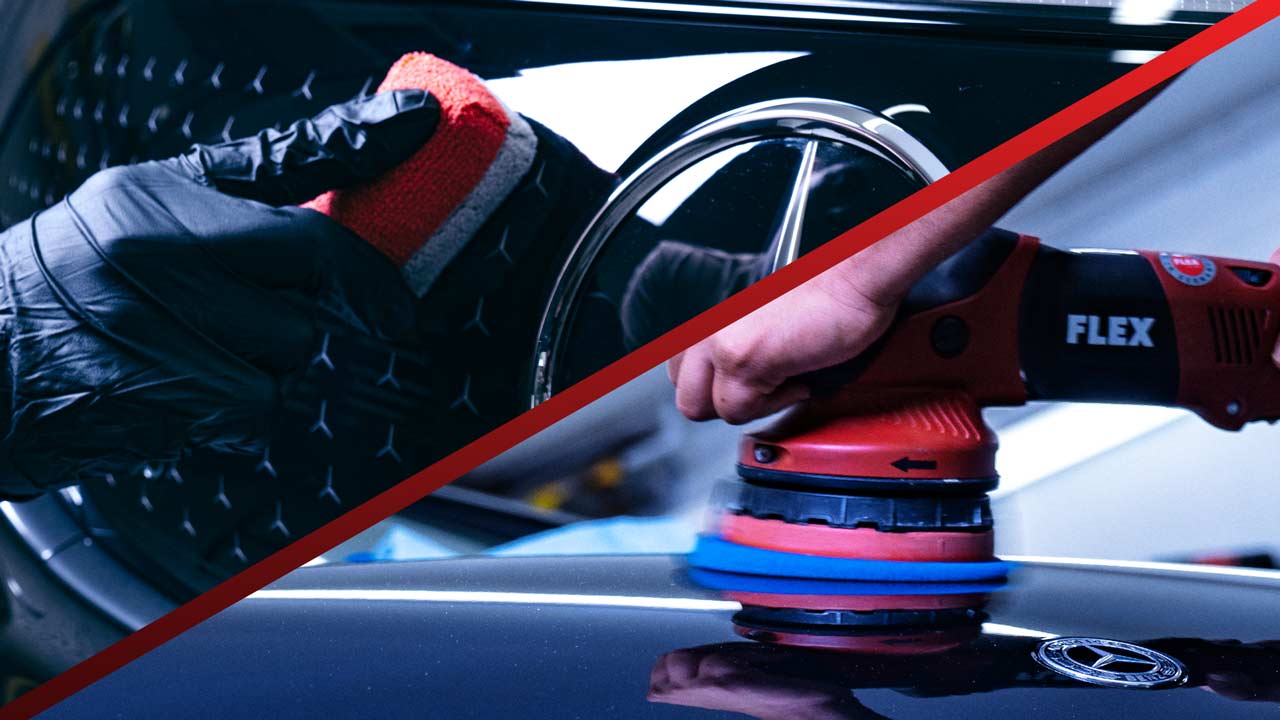If you’ve ever wondered whether you can polish a ceramic coating after application, you’re not alone.
Over time, a ceramic coating can develop unsightly swirl marks from improper washing and stains or etch marks from acid rain, bird droppings and bug guts.
On top of that, improper application of the ceramic coating can cause uneven high spots that stick out like a sore thumb.

Polishing a ceramic coating could remove these stains, swirls and high spots in theory, but that begs the question: can you even polish a ceramic coating to begin with?
The short answer is yes; but you may have to re-apply the coating afterwards.
In this article, we’ll go over when it’s a good idea to polish a ceramic coating, how to polish a ceramic coating to remove stains and high spots, plus how to re-apply the ceramic coating after polishing.
Is It Possible to Polish a Ceramic Coating After Application?
Yes, you can polish a ceramic coating after application to remove swirls, stains or high spots. That being said, it must be approached with care to avoid damaging or removing the coating.
Polishing is an abrasive process of material removal, and if you polish a ceramic coating too aggressively, you can remove it in the process. After all, ceramic coatings are extremely thin, typically measuring between 1-3 microns in thickness.
This is why you want to use low aggression polishing processes on ceramic coatings. Using a soft foam polishing pad with a light finishing polish and a random orbital polisher set to a low speed is gentle enough not to remove the ceramic coating.


When Should You Polish a Ceramic Coating?
Polishing a car’s ceramic coating is only advisable under certain conditions:
- High Spots: These are areas where excess coating has accumulated, creating uneven, dark, or hazy patches on the surface. These spots occur when the coating isn’t leveled properly during application, often requiring light polishing to correct.
- Bonded Stains: Contaminants such as tree sap, bird droppings, or industrial fallout that bond with the ceramic coating and require polishing to remove.
- Etch Marks: Shallow grooves or indentations caused by acidic substances like bird droppings or water spots, which chemically eat into the ceramic coating, leaving behind visible damage that may require polishing or more intensive correction.
- Swirl Marks: Paint dulling fine scratches that form a swirl pattern under strong light, often caused by improper washing or drying techniques. They require polishing to remove.
The fact is, ceramic coatings are not impervious shields. They are sacrificial layers intended to absorb the impact of scratches and stains so the paint doesn’t have to. Think about it this way — if your ceramic coating has scratches, it’s doing its job.

What Type of Polish Should You Use on Ceramic Coatings?
When polishing a ceramic coating, it’s best to use a fine or finishing polish with minimal abrasiveness to avoid removing the coating entirely. Look for polishes labeled as “non-cutting” or “ultra-fine,” which are designed to correct light surface defects like swirl marks without degrading the protective layer.
Avoid using heavy-cut compounds, as they are too aggressive and can strip the coating off the paint. Pairing the polish with a soft foam pad rather than a cutting or microfiber pad will help minimize abrasion and preserve the coating.
How to Polish Ceramic Coatings to Remove Swirls, Stains & Water Spots
- Wash and Decontaminate the Surface
- Thoroughly wash the vehicle using a pH-neutral car wash soap to remove dirt and debris.
- Use a clay bar to eliminate any bonded contaminants on the surface.
- Dry the vehicle completely with a soft microfiber towel, blower or combination of the two to prevent introducing new swirl marks.
- Inspect the Coating for Swirls
- Under proper lighting, examine the paint for swirl marks, stains and water spots and determine the severity of the defects.
- Select the Right Polish and Pad
- Use an ultra-fine or finishing polish to avoid removing too much of the coating.
- Pair the polish with a soft foam pad or a light polishing pad to minimize abrasion.
- Prepare the Polisher
- Attach the selected pad to a dual-action (DA) polisher. Do not use a rotary polisher.
- Apply a small amount of polish (3-4 pea-sized drops) on the pad.
- Test a Small Area First
- Test the polish on a small, inconspicuous section to ensure it corrects the swirl marks, stains or water spots without stripping the coating.
- Adjust speed and pressure as needed, using low to medium settings on the polisher.
- Polish the Surface
- Work in a small area at a time, moving the polisher in eight overlapping, cross-hatch section passes.
- Use light to moderate pressure, and keep the polisher moving to prevent heat buildup and over-polishing.
- Check Your Progress
- Wipe away excess polish with a clean microfiber towel to inspect the area under good lighting.
- Repeat if necessary, but avoid going over the same area excessively to prevent coating removal.
- Clean and Inspect the Entire Surface
- Once the swirl marks are corrected, go over the entire surface with a soft microfiber towel to remove any leftover polish residue. If using organic polishes, remove residue using a panel wipe.
- Inspect the surface for uniform gloss and smoothness.
- Re-Apply Ceramic Coating (If Necessary)
- If the polishing process removes the ceramic coating or enough to jeopardize the paint’s protection, you’ll want to apply a new layer of coating following the polishing process. Remember — at least you’re not re-applying the paint!
How to Polish Ceramic Coatings to Remove High Spots
- Identify High Spots
- Inspect the surface under bright lighting or direct sunlight to spot any hazy, dark, or uneven areas where excess coating has accumulated.
- Reflecting white paper or poster board against the paint can help identify high spots.
- Mark these areas with low-adhesive painter’s tape, if needed, to track them as you work.
- Gather the Necessary Tools
- Microfiber towels
- A light polish or finishing compound
- Dual-action (DA) polisher (Rotary not recommended)
- Soft foam or finishing pads
- Ceramic coating
- Try Wiping with a Microfiber Towel First
- If the high spot is fresh (within the last few hours of application), gently buff the area using a clean microfiber towel.
- Sometimes re-applying the coating can re-emulsify the high spot so it can be leveled out.
- In some cases, this may level the coating without the need for further polishing.
- Polish the High Spot
- If the high spot has cured, use a fine finishing polish with a soft foam pad to correct the uneven surface.
- Apply a small amount of polish on the pad and work in small, controlled sections to avoid over-removal of the coating.
- If using a polisher, set it to a low speed to prevent excessive abrasion.
- Polish in Cross-Hatch Patterns
- Move the polisher in horizontal and vertical overlapping passes across the high spot to evenly blend the area with the surrounding coating.
- Apply light pressure to avoid cutting through the ceramic layer entirely.
- Wipe and Inspect
- Use a clean microfiber towel to wipe away polish residue and check the area under good lighting.
- Ensure the surface is even, with no remaining high spots or hazy patches.
- Apply a Coating Touch-Up (If Necessary)
- If you accidentally remove too much of the coating, apply a small amount of the ceramic coating over the affected area following the manufacturer’s instructions.
- Allow it to cure properly to restore the protective layer.

How to Avoid Scratches, Swirl Marks, Stains and Water Spots on Ceramic Coatings
While ceramic coatings provide excellent protection and enhance the gloss of your vehicle, they are not invincible. Improper maintenance can lead to scratches and stains that compromise the coating’s performance and appearance.
To avoid needing to polish your ceramic coating (and potentially removing it in the process) follow these maintenance techniques:
1. Washing Techniques to Avoid Scratches
- Use the Two-Bucket Wash Method: One bucket for soap and another lined with a Grit Guard for rinsing your wash mitt. This prevents dirt from transferring back onto the paint.
- Choose a Soap for Ceramic Coatings: Car wash soaps with active surfactants break down contaminants so you don’t need to rub on them with a wash mitt.
- Use a Soft Wash Mitt: Microfiber mitts reduce the chances of dragging dirt across the surface and causing micro-scratches.
- Dry with a Microfiber Towel or Air Blower: Avoid using household towels, as they can leave fine scratches. Dry with a soft microfiber towel or use an air blower to remove water safely.
2. Preventing Bonded Stains and Etching
- Clean Bird Droppings and Tree Sap Immediately: These contaminants are acidic and can etch through the coating if left for too long. Use a gentle cleaning spray designed for ceramic coatings.
- Avoid Hard Water Spots: Wash the car in shaded areas and dry it immediately to prevent mineral deposits from forming stains.
- Use a Ceramic Spray: Regularly applying a maintenance spray helps add a protective layer that resists contaminants and water stains.
3. Best Practices for Safe Maintenance
- Avoid Automatic Car Washes: The rough contaminated brushes used in most automated washes can leave swirl marks and fine scratches on the coating. Opt for touchless washes if handwashing isn’t an option.
- Don’t Wash the Car in Direct Sunlight: Washing in high heat can cause soap and water to dry too quickly, leaving behind residue and spots.
- Use a Dedicated Microfiber Towel for the Coating: Keep separate towels for the coated surface to prevent contamination from other areas, such as wheels.
4. Additional Tips to Avoid Damage
- Inspect and Replace Wash Tools Regularly: Old mitts or towels with embedded dirt can cause scratches. Replace them if they show signs of wear.
- Use a Waterless Wash or Rinse-Free Wash Solution for Light Cleaning: These solutions are safer for quick clean-ups when the car isn’t heavily soiled.
- Apply a Top Coat or Boosting Spray Periodically: Many ceramic coatings have compatible sprays that rejuvenate the coating and enhance its hydrophobic effect.
5. Routine Inspection and Early Intervention
- Inspect the Coating Under Good Lighting: Regular checks help catch swirl marks, stains, or high spots early.
- Keep a Ceramic Coating Maintenance Kit in the Car: Carry a microfiber towel and a quick detailer for emergencies, such as bird droppings or tree sap.
- Schedule a Professional Inspection: If you notice scratches or stains that are difficult to remove, consult a professional detailer for appropriate correction.
By following these practices, you’ll minimize the risk of scratches and stains, keeping the ceramic coating intact and looking pristine — without the need to polish it!




